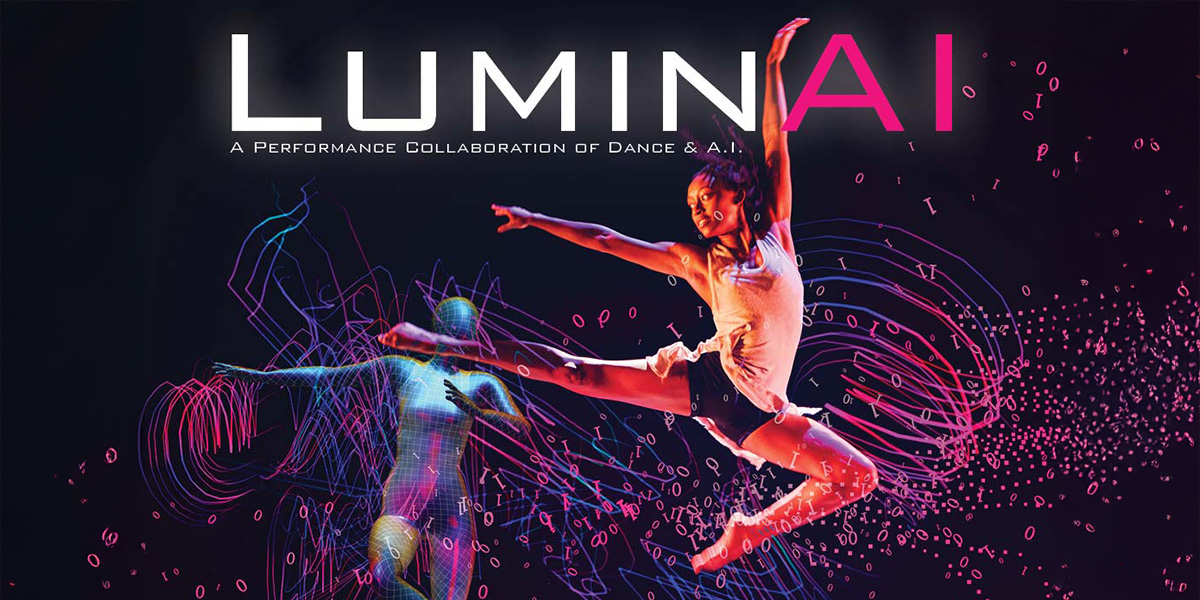Can artificial intelligence stay in step with human dancers? The answer is yes. Kennesaw State University KSU is no stranger to groundbreaking research, but the world’s first improvisational dance between humans and AI is on a whole new level. And the combination could influence a wide variety of disciplines.
Through a collaboration between KSU’s Department of Dance and the Georgia Institute of Technology, we’re bringing “LuminAI,” an avatar and digital partner powered by artificial intelligence, to dance alongside human performers and improvise based on their movements.
Fueled by an NSF grant, this AI/human performance is the result of three years of intense collaboration between Brian Magerko of Georgia Tech’s Expressive Machinery Lab and KSU’s very own Andrea Knowlton, Associate Professor of Dance.
The LuminAI project pushes the boundaries of what’s possible when it comes to how humans and machines create art together. As Knowlton explains, “In this performance, we are using AI to respond to human movement, and actually co-create together, in the moment.”
Brian Magerko, who leads Georgia Tech’s Expressive Machinery Lab, explains how the avatar, or agent, learns from human dancers by observing their movements. Using open pose software, the AI system breaks down these movements into gestures. After learning the gestures, it applies its understanding to respond in real-time. In essence, the avatar is improvising alongside the human dancer.
Direct motion capture allowed LuminAI’s database to collect around 5,000 individual movements from students. In a similar fashion, dance participants annotated their movements, which deepened their understanding and awareness of their techniques. This interaction not only helped the AI become better at responding to human movements but also gave researchers a ton of valuable insights into creating smarter, more intuitive AI systems.
“We created a taxonomy of movement that catered to machine learning and its specific capabilities and limitations in relation to seeing and understanding human movement,” said Knowlton, who added this research effort has braoder implications that go far beyond artistic expression.“ Areas such as dance therapy and physical therapy could be greatly enhanced due to machine learning. The collected information could even lead to advancements in gaming.”

KSU’s role in this project reflects the university’s growing strength in interdisciplinary research. By pairing the arts with the latest in AI technology, we position ourselves as a pioneer in integrating technology into creative fields—and potentially beyond dance. While the tech world often focuses on data and machine efficiency, LuminAI adds a layer of human emotion and unpredictability to the mix (qualities that machines traditionally lack).
For KSU, this means much more than participating in a unique performance. LuminAI and the dance students’ first performance on May 3, 2024, at KSU’s Dance Theater in Marietta, showed audiences that one of the biggest accomplishments was bringing together scientists, engineers, artists, dance enthusiasts, musicians, and students. Before that day, most of the Georgia Tech scientific team had never performed on stage. Seeing the art and avatar work made a profound impact—knowing there is a space for advancing knowledge in both science and the arts.
For students considering where they can push the boundaries of their own education, KSU offers more. LuminAI is one example of how students here aren’t confined to classrooms or traditional study tracks—they can be active participants in innovative projects that the world has yet to see. Knowlton’s Dance Improvisation class played a key role in teaching the AI system, giving students a one-to-one experience with the intersection of tech and art.
Knowlton mentions some students were initially hesitant to dance with a machine, but over time, they embraced the challenge. “Sometimes, the agent’s responses to the human are not exactly what you would expect—because it isn’t a human—so it can bring elements of surprise and humor,” she said.
As this new-age performance takes center stage, it raises important questions about the role of AI in our daily lives, and whether machines can ever truly understand or replicate human creativity. The LuminAI project challenges that very notion, showing that collaboration between humans and machines can lead to something entirely new.
Curious about KSU’s latest breakthroughs?